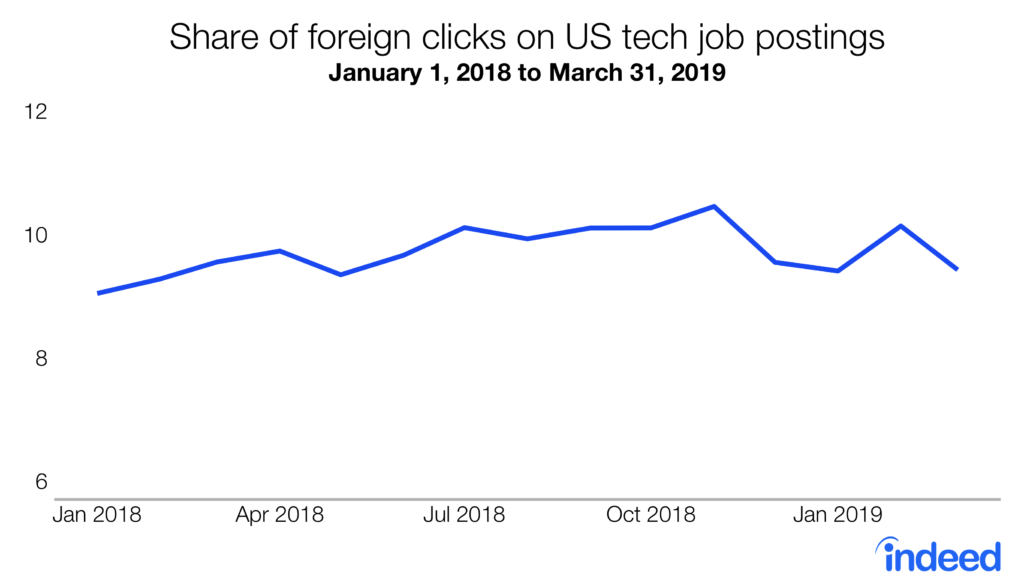How has a strong US labor market and a volatile political situation affected global interest in US tech jobs? A steady share of job seekers living abroad is clicking on US tech postings, even as interest has declined from India, by far the largest source of foreign clicks on tech jobs. And the tech jobs workers abroad are most keen on are difficult-to-fill, highly-paid positions in software development and engineering.
In early 2019, the foreign share of clicks on US tech job postings on Indeed.com edged up from 9.3% in the first quarter of 2018 to 9.6% in the first quarter of 2019. For context, the share of foreign clicks on US tech jobs is below the foreign click share of around 15% on Canadian tech jobs in February 2019.

When it comes to foreign clicks on US tech jobs, there’s India and then there’s everyplace else. In the year ended April 1, 2019, 3.7% of all clicks on US tech jobs came from IP addresses in India. Canada was far behind at 0.6%, followed by the UK at 0.4%.

Of the top 10 countries by clicks on US tech jobs, Germany, France, and Russia had the largest year-over-year increases in their shares of all tech clicks, each up more than 25% in the first quarter of 2019. However, India was down 8% year-over-year, while Pakistan fell 37% and the UK 12%.

French interest surged from September through December 2018, starting before the Yellow Vests movement, which flared up most dramatically in November.
Developer jobs receiving the highest foreign interest
The tech jobs most clicked on by foreign job seekers in the first quarter of 2019 were all developer and engineer roles. Many specialized, software-intensive positions dominate the list. About 44% of clicks on senior Java developer postings came from abroad. And whether it’s Python or PHP, Android or iOS, highly skilled programmers from abroad are clicking on US job postings at rates between 27% and 38%. By comparison, of the 571 tech job titles studied, the median foreign click share was 8.7%.

On the flip side, the tech jobs that drew the least interest from foreigners included technician and support roles, as well as some analyst and manager positions. For the most part, these tech jobs require fewer technical skills and less education. A meager 1.6% of clicks on entry-level IT technician came from foreign IP addresses. Other technical support or help desk positions had foreign click shares below 3%, well below the median foreign share of clicks on tech roles.

Foreign interest appears to be highest for difficult-to-fill tech jobs. One measure of this is a job title’s average clicks per posting. The higher the clicks per posting, the greater the number of potential applicants. There is a clear relationship between a higher foreign click share and a lower clicks-per-posting ratio. In the chart below, clicks per posting has been normalized (see methodology section for details).

Similarly, tech jobs with higher average salaries also had higher foreign click shares. This relationship may reflect visa requirements. Visas, such as the H-1B, are expensive to process. To make it worthwhile to an employer, these workers should be highly skilled and worth the cost.

Despite the strident debate over immigration in the US, the growth of foreign interest in US tech jobs seems to have held steady over the past year. And, luckily for US-based businesses, these foreign job seekers are interested in tech roles that see fewer clicks. Without foreign job seeker interest in these difficult-to-fill tech jobs, employers would probably have to make big adjustments to find suitable candidates.
Methodology
Foreign clicks are defined as those coming from IP addresses outside the US. We used a list of 571 job titles to identify tech job postings. Only postings based in the US and in English were considered. We looked at the overall foreign and specific country click share on tech jobs from January 1, 2018 through March 31, 2019.
For specific tech job titles, the time period was from January 1, 2019 through March 31, 2019. Tech jobs were only analyzed if they had a minimum of 50,000 total clicks. For salaries, tech jobs needed a minimum of 100 job postings with an estimated salary. The clicks-per-postings measure was normalized to 1.0, based on the weighted average of the clicks-per-posting measure for all tech job titles (weighting by clicks).






